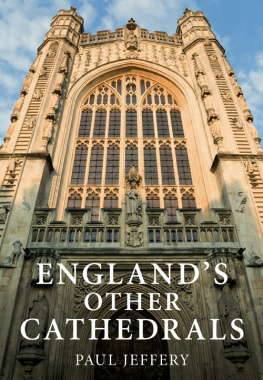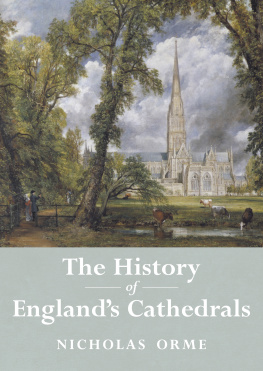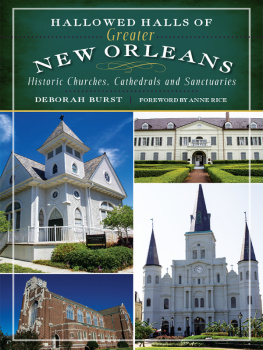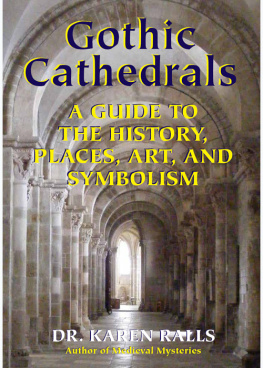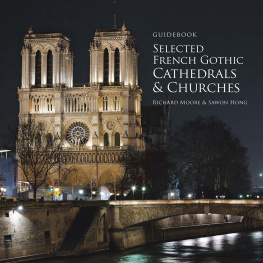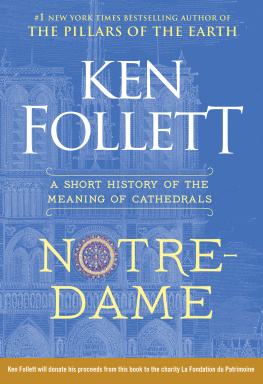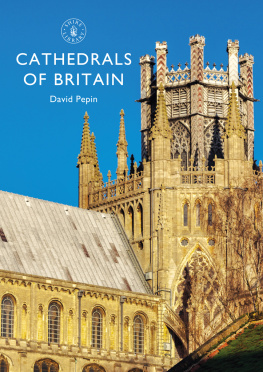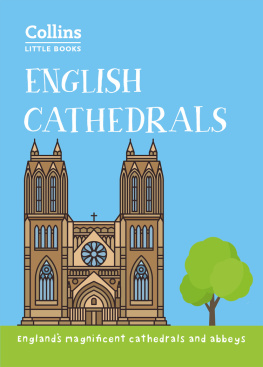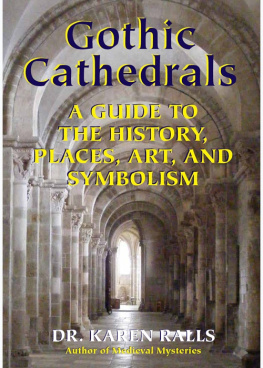Jeffery - Englands Other Cathedrals
Here you can read online Jeffery - Englands Other Cathedrals full text of the book (entire story) in english for free. Download pdf and epub, get meaning, cover and reviews about this ebook. year: 2012, publisher: Stroud The History Press, genre: Religion. Description of the work, (preface) as well as reviews are available. Best literature library LitArk.com created for fans of good reading and offers a wide selection of genres:
Romance novel
Science fiction
Adventure
Detective
Science
History
Home and family
Prose
Art
Politics
Computer
Non-fiction
Religion
Business
Children
Humor
Choose a favorite category and find really read worthwhile books. Enjoy immersion in the world of imagination, feel the emotions of the characters or learn something new for yourself, make an fascinating discovery.
Englands Other Cathedrals: summary, description and annotation
We offer to read an annotation, description, summary or preface (depends on what the author of the book "Englands Other Cathedrals" wrote himself). If you haven't found the necessary information about the book — write in the comments, we will try to find it.
Englands Other Cathedrals — read online for free the complete book (whole text) full work
Below is the text of the book, divided by pages. System saving the place of the last page read, allows you to conveniently read the book "Englands Other Cathedrals" online for free, without having to search again every time where you left off. Put a bookmark, and you can go to the page where you finished reading at any time.
Font size:
Interval:
Bookmark:

For my wife Margy, with love
The great cathedrals of England are our finest and best-loved buildings.
They are the background to this book. Its genesis came in part from my appreciating the broader meaning and significance possessed by the word cathedral and the concept that it represents. As well as being used for those great churches, the word has come to be applied figuratively to almost anything exceptionally large and fine: St Pancras Station in London is the Cathedral of the Railway Age; the $8 billion Large Hadron Collider completed at Geneva in 20089 has been called a cathedral of science; and the symphonies of Anton Bruckner are sometimes described as cathedrals in sound. Moreover, cathedrals have inspired many forms of secular art: Constable and Turner both produced famous paintings of Salisbury Cathedral. Novels, too, have been written on the theme of a medieval cathedral construction project. The Whipsnade Tree Cathedral, planted in the 1930s, has trees, hedges and shrubs around grassy avenues in the shape of a cathedral and its cloisters.
With this came the realisation that around or related to the great cathedrals as we know them today, there are, or were, many more similarly remarkable churches. Some have, or had, true cathedral status, others not. We might call them churches with cathedral connections. They share many of the qualities of the great cathedrals: in varied ways they have much of the cathedrals splendour, excitement and fascination. They reveal much interesting history, and are a large and enthralling subject. Englands great cathedrals as generally considered may be numbered as twenty-six; discussed in this book are well over a hundred other cathedrals.
One such group is of cathedrals that with the march of history have lost their cathedral status. Some ceased in the Anglo-Saxon era; others ended in the later medieval centuries. A few began but were never completed. Another fascinating category comprises the churches that were identified to become new cathedrals under Henry VIII, but in the event did not or, after a brief existence, ceased.
Many of the existing great cathedrals had predecessors. It is well known that the present St Pauls in London replaced a medieval cathedral; but even that had yet earlier ancestors, back into Anglo-Saxon times. So did many others.
The great cathedrals are all ancient (if we allow this of the seventeenth-century St Pauls); but many relatively modern cathedrals also exist. Unlike the ancient cathedrals, they belong to multiple denominations: Anglican, Roman Catholic, and others too. A few are famous, notably Coventrys, which came out of the destruction of war, and the two at Liverpool. But most are little known.
Two further groups have, instead of a historical connection to the true cathedrals, a different type of relationship. One is of churches that use the cathedral name informally, while those of the other are defined by their cathedral-worthy size and splendour.
So addressed in this book are eight groups of other cathedrals. They are a very diverse set. In part this diversity applies to their size and character, but all groups contain churches that are large and splendid, and most include some that are fully comparable with the great cathedrals. They are varied in date too, ranging from the seventh century to the twenty-first. Most widely varied of all is their condition today. Among them are many, from all periods, that stand gloriously complete, while others, though themselves destroyed, have been replaced by a splendid successor. Yet others are mutilated or are roofless ruins: some of these are still fine and beautiful but others are only sad relics. Then there are those that are now no more than sites empty or covered by later structures though even these may have been fascinatingly illuminated by archaeology. A few have nothing more than their history, with even where they once stood being unknown.
Visiting these churches and sites all round the country has been a rewarding task. Equally fascinating has been the research into their background and history. Many people have helped me. First among these is Dr Charles Knighton, to whom I offer my warmest thanks for his assistance concerning the Henry VIII cathedral schemes. Others to whom I am particularly grateful are Lucy Beckett, Anthony Cornwell, Professor J.J. Scarisbrick, Dr Joanna Story and Professor Barbara Yorke. I also thank Derek Adlam, Keith Barker, James Bettley, Professor Martin Biddle, Professor Christopher Brooke, Richard Buckley, Dr John Crook, Philip Dearcy, the Revd Michael Dolan, Toria Forsyth-Moser, Bill Jerman, the Very Revd Peter Judd, Phil McGahan, Cath Moloney, Canon Barry Naylor, Fr Vassilios Papavassiliou, Dr Arthur Percival, Konstanze Rahn, Professor Warwick Rodwell, Graham Scobie, Gill Shrimpton, Tessa Smart, Mrs Barbara Solomon, Mrs Margaret Sparks, Peter Stretton, Jane Sumpter, Tim Tatton-Brown, Sally Thompson and Maureen Tooze. I express my appreciation of the services offered, without charge, by those excellent institutions, our libraries, particularly the Martial Rose Library of the University of Winchester, the Hartley Library of Southampton University, the Minster Library at York and the Public Record Office in Kew. Last but not least, I thank my wife for her encouragement and help. Photographs were taken by me except where otherwise indicated.
Cathedrals are supreme works of art and architecture. Arguably, Englands ancient cathedrals are the countrys greatest treasures. Architectural historian Alec Clifton-Taylor called them the master-works of English architecture. Although created hundreds of years ago, their artistic achievement has hardly been matched by any creations of our age.
Cathedrals are also prodigies of engineering. Even by the standards of todays buildings they are very large. Some are notably tall: the spire of Salisbury Cathedral was the countrys tallest building as recently as the 1960s. Cathedrals are also exceptional in the size of their continuous enclosed spaces. Although size is a technical rather than an artistic achievement, it is an essential component of their inspirational character, especially powerful when we consider the elementary technology available to their makers. We feel the cathedrals were made as the greatest and most beautiful things that their creators could conceive; they are often said to have been built to the glory of God, and in many ways this must be true.
Moreover, cathedrals are frequently of outstanding historical importance. Some go back to the early years of Christianity in England. They may be connected with major historical events and with figures prominent in the countrys history. Within them are to be found tombs of many great men and women of the past.
A measure of the importance of the cathedrals in our national culture is the number of visitors they receive. York and Canterbury have the highest numbers, each with over 2 million annually. Altogether, the cathedrals receive perhaps 15 million a year. As attractions, they rank high among the most popular.
The central value of a cathedral its reason for existence is religious. Cathedrals are the most spectacular physical manifestation of Christianity. A cathedral has a specific function: it contains a cathedra, the throne of a bishop, and it is this that gives it its name. A bishop has ecclesiastical jurisdiction over an area or territory known as a diocese. A few cathedrals, such as Canterbury, have the additional dignity of being the seat of an archbishop, who presides over a larger area known as a province.
The religious aspect stands beside their art, their engineering and their history as an essential part of their importance. Some who visit them are Christians visiting for religious reasons; but most probably are not. Yet for a large proportion of visitors the fact that cathedrals are religious buildings is part of their value. They inspire awe, reverence and wonderment. All the great cathedrals and many of the other cathedrals are the property of a Church, which is responsible for their care and maintenance and for which they are working buildings. They are not museums.
Next pageFont size:
Interval:
Bookmark:
Similar books «Englands Other Cathedrals»
Look at similar books to Englands Other Cathedrals. We have selected literature similar in name and meaning in the hope of providing readers with more options to find new, interesting, not yet read works.
Discussion, reviews of the book Englands Other Cathedrals and just readers' own opinions. Leave your comments, write what you think about the work, its meaning or the main characters. Specify what exactly you liked and what you didn't like, and why you think so.

